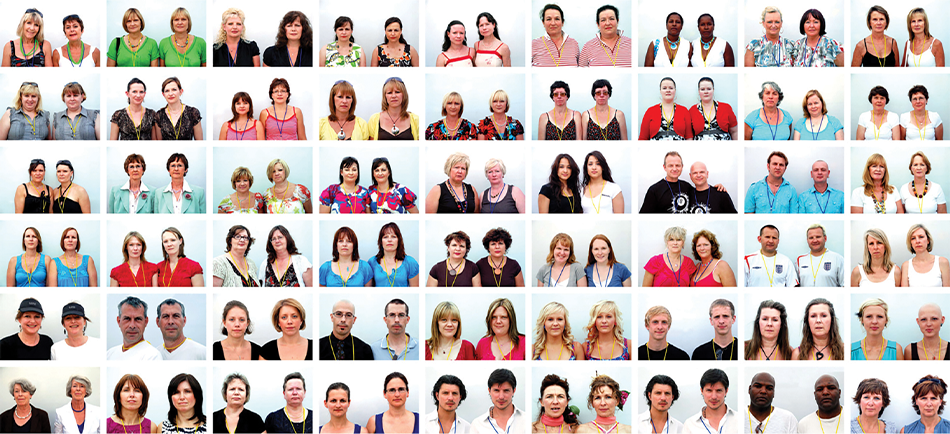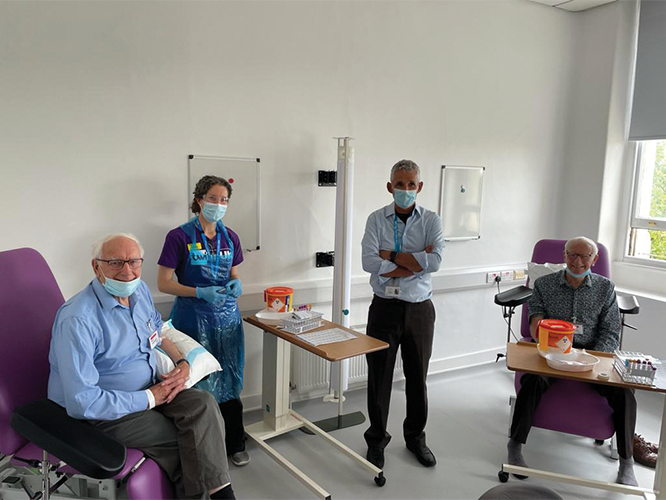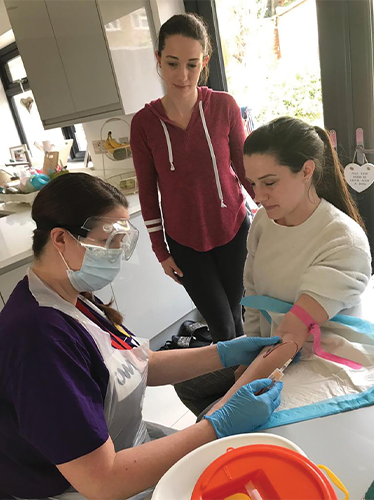Back in 1992, when Prof. Tim Spector of King’s College London set up a study to investigate the incidence of osteoporosis and other rheumatologic diseases in monozygotic (identical) twins, little did he know how much the project would expand its horizons. From a few hundred identical twins, the cohort has grown to more than 15,000 identical and nonidentical twins across the U.K., aged between 18 and 100, and a host of diseases and conditions are under the microscope (Figure 1). Now, TwinsUK has one of the most deeply characterized adult twin cohorts anywhere in the world, providing vast quantities of data for longitudinal studies of health and aging.
“The first goal was to use the classical twin model to study osteoporosis and osteoarthritis, about which little was known,” explains Dr. Claire Steves, professor of ageing and health at King’s College London and clinical director of TwinsUK. “Those diseases were in an empty space in terms of research—and to some extent still are.”
“The research showed a substantial genetic component for osteoarthritis, which is not just the result of wear and tear,” she adds. “From there, as more people joined the community the scope became broader, as participants suffer from different diseases and there are often interrelationships between conditions. Multimorbidity research is a growing area now and the twin design model is very useful for that.”
Beyond genetics
TwinsUK began in the 1990s as a tool for comparing the impact of genetics and environmental factors on specific conditions, but advances in the availability of genetic information over the decades have given it room to broaden its focus (Figure 2). For instance, large studies such as UK Biobank—a large-scale biomedical database and research resource containing in-depth genetic and health information from more than 500,000 U.K. participants—can examine huge cohorts. Globally accessible and frequently augmented with additional data, it has played a role in several scientific discoveries.
“Now, we are interested in using twins to understand how different destinies in life lead to different outcomes,” remarks Steves. “That means environmental factors but also personal choices. There is often discordance in environmental exposure and outcomes, and twins can show that more than other studies.” This was particularly useful during the COVID-19 pandemic, when data from TwinsUK enabled researchers to compare people with different exposures, outcomes, and biological differences.

Figure 1. More than 15,000 identical and nonidentical twins across the U.K. are part of TwinsUK, providing vast quantities of data for longitudinal studies of health and aging. (Photo courtesy of TwinsUK.)
“Furthermore, twins and other family design studies are interesting because working with pairs of individuals greatly increases engagement,” says Steves (Figure 3). “They enjoy being part of a pair in the study, so we have had amazing engagement among people with similar genetics but also a similar early life environment.”
“Socioeconomic factors are very important, and we can remove some of the noise from later life environmental factors by using twins, though their early life experiences are not exactly the same,” she adds. “We are also looking at somatic mutations—changes in DNA that occur after conception and are not passed on to children—particularly in blood, where there is a bigger potential for small mutations to occur. These can be used as a marker for aging and a potential outcome trait.”
Growing old gracefully
TwinsUK continues to push far beyond its initial brief, having generated more than 1,000 research papers in fields as diverse as aging, pain, vision, nutrition, genetics, and trait heritability. It also has generated a vast number of phenotypes—sets of observable characteristics in an individual resulting from the interaction of its genotype with the environment—and has thrown a spotlight on how different diseases overlap, thus helping to identify common risk factors.

Figure 2. In 1992, Prof. Tim Spector of King’s College London (second from right) set up a study to investigate the incidence of osteoporosis and other rheumatologic diseases in monozygotic twins. Today, he continues to lead what has become one of the largest twin studies in the world, contributing research on aging, genetics, gut microbiome, and more. (Photo courtesy of TwinsUK.)
“Twins are incredibly engaged in giving biological insights,” notes Steves. “With twins we can show scientific insight with a smaller number of participants, as we can easily relate changes in epigenetic tags or expressions of genes in different tissues or in the microbiome.”

Figure 3. Working with pairs of twins not only increases engagement in the study, but offers similar genetics with a similar early life environment for comparison to the potential effects of environmental factors on health. (Photo courtesy of TwinsUK.)
For Steves, whose work includes a role as a consultant geriatrician at Guys and St. Thomas’s NHS Foundation Trust, aging is the standout area of interest and TwinsUK has generated some intriguing insights into key factors, notably the role of telomeres—compound structures of nucleotide sequences at the ends of linear chromosomes—and the effect of diet on the aging and rates of cognitive decline.
“Telomeres are often replicated over time and there is attrition of telomeres but also DNA repair,” says Steves. “As with epigenetic change, factors such as telomere length can be affected by socioeconomic factors, so there is a clear overlap between societal issues and genetics. There is no ticking clock for changes to DNA. Instead, many variables affect it and studying twins allows us to affect that process.”
Understanding that the process of aging is not simply carved indelibly into a body’s genetic code means that Steves and her team can focus on functional outcomes and how changes in behavior can play a role. “Telomere length is interesting to study but it is not very alive for people, so we can look at functional differences through questionnaires and measuring physiology in person, including their ability to do tasks,” she remarks. “It is all about finding applications for the science, not just doing the science itself.”
“A core driver for us is to work out how we use this understanding of how people age differently to help everyone age better, which is not the same as extending lifespan,” she continues. “It is about quality of life. On average, women have 19 years at the end of life when they can’t do what they want—men have slightly less—as women accrue functional deficits along the way more than men do.”
Looking inside the gut
The focus on improving quality of life is a key reason why the data TwinsUK has generated has been used extensively to compare the effect of diets on the gut microbiome, which can determine if a person is fat or thin. It was a twins study (see [1]) that first kicked off excitement about the gut microbiome by examining its role in lean and obese twins. TwinsUK has continued this work by characterizing the gut microbiome of twin volunteers using sequencing of 16s rDNA and entire metagenomes, to understand the role of the microbiome in human health and disease.
“Fecal samples were taken from twin pairs where one was obese and one not, and they were put into mice,” explains Steves. “The mice who got the obese twin’s stool put on weight. This is the first causal experiment to show that it is not just about diet and physical activity, but also microbiome and metabolism.”
“That led to a huge amount of interest across the world, so we started to collect stool in 2010 and have a huge dataset showing that gut microbes are not really driven much by genes,” she adds. “There is a substantial contribution of genetics at the start in terms of obesity that explains some traits, but on average the microbiome is only 17% a result of genetics.”
In fact, research has shown that the environment in which a person lives has a big effect on the microbiome due to the effect of social inequality on diet, differences between urban and rural areas, the availability of nutritious diets, and the effect of medications. For instance, proton pump inhibitors (PPIs), which are medicines that work by reducing the amount of stomach acid made by glands in the lining of your stomach, have a beneficial effect on stomach ulcers but can devastate the gut microbiome.
“I look at the development of frailty because of changes in organ systems, examining why some people become severely unwell from mild illnesses,” Steves explains. “The microbiome is very different in a frail twin, and robustness is linked to anti-inflammatory bacteria. We can see the benefits of a high-fiber diet with lots of fruit and vegetables, so we know there is something we can do that makes a difference.”
Billions of data points
All of the insights gleaned from the TwinsUK project stem from the billions of data points it has generated, which have been made available to researchers around the world. The project is funded by the Wellcome Trust, which has a commitment to open science and data sharing, so TwinsUK has set up data-sharing and ethics protocols to let scientists use the data. More than 1,000 data access collaborations and 250,000 samples have been shared with external researchers, resulting in over 800 publications since 2012.
“The response has been fantastic, and it was dramatically accelerated during the pandemic,” says Steves. “For instance, the UK Longitudinal Linkage Collaboration has harmonized how data is shared and used appropriately, and this harmonization across cohorts really accelerates findings. We can get insights together quickly and publish on topics such as mental health and long Covid where we can’t do randomized controlled trials.”
“It has helped to take the brakes off collaboration because researchers can share methodologies and pool data,” she adds.
With this open approach to data-sharing, as well as a huge cohort of participants, TwinsUK is still expanding its scope after 30 years. For example, Steves is starting to investigate how changes in diet can optimize the aging process as the world responds to climate change. The range of potential applications for such a rich source of data is potentially limitless, and the U.K.’s population of twins will no doubt continue to be the inspiration for many more ideas that make a healthier world for human beings. <
Reference
- P. J. Turnbaugh, F. B äckhed, L. Fulton, and J. I. Gordon, “Diet-induced obesity is linked to marked but reversible alterations in the mouse distal gut microbiome,’’ Cell Host Microbe, vol. 3, no. 4, pp. 213–223, Apr. 2008. [Online]. Available: https://pubmed.ncbi.nlm.nih.gov/18407065/



